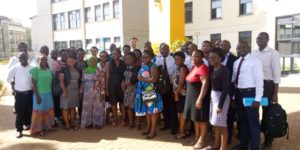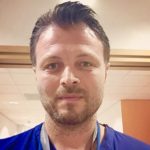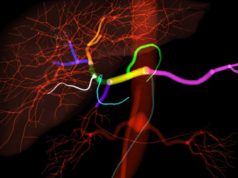
It is time to change patient care for an entire country, writes Gregory Makris. After travelling to Uganda and learning that the country’s 40 million strong population had no access to interventional radiology services, Makris felt the scale of the difficulties besetting healthcare providers in such a resource limited environment, and the urgency of introducing these life-saving procedures to those in need. Here, he gives a first-hand account of how he has been working with the Uganda-UK health alliance and other national and transnational organisations to establish an interventional radiology service in the East African nation.
It is almost 9am and we have just landed in Entebbe international airport after 12 hours of flying through the night. I am a bit tired, but the nice warm breeze of the tropics is welcoming and definitely a pleasant change from the cold and rainy weather of London. The drive to Kampala, capital of Uganda, takes around an hour and half and, having never been to East Africa before, I am slightly nervous. The scenery around us is beautiful; we are in the middle of the rainy season and everything is green and colorful. Lake Victoria, source of the world’s longest river, the Nile, is right next to us, and a quick swim in the cool waters is tempting…
As we approach Kampala, the traffic becomes heavy, providing the first idea of how busy this city of one and half million people is. Boda-bodas—small motorbikes that constitute the main means of transportation in the city, sometimes seemingly dangerously loaded with several passengers—weave amongst the bustle. As we get deeper and deeper into Kampala, the scenery changes considerably, developing a more urban look with open markets everywhere. The packed city’s populous are very friendly, and always more than happy to help. This is despite the large number of people still living in extreme poverty following the long civil war between the North and the South which racked the country, from which its 40 million inhabitants are still recovering.
Uganda became independent from the British in 1962, but has maintained strong links to the UK since. The Uganda-UK health alliance is a great example of this relationship. In 2013, the Uganda-UK health alliance was launched in Kampala as a partnership of UK- and Uganda-based organisations that share a common interest in health developments in Uganda. Initially hosted by the University Hospital of South Manchester NHS Foundation Trust (UHSM), the alliance was underpinned by a Memorandum of Understanding signed by 31 UK-based and 17 Uganda-based public and third-sector organisations, as well as the Ugandan Ministry of Health. One of these organisations is the global engagement division of Health Education England (HEE), which, under the leadership of Professor Ged Byrne (Manchester, UK), has been contributing to the improvement of health care standards in the region. It was when I first met Professor Byrne during a trip for another project that I realised an entire country of 40 million people had absolutely no interventional radiology (IR) service. I was shocked—something had to be done about it, and thankfully HEE and the Uganda-UK health alliance were incredibly willing to help.
Uganda has around 50 radiologists, which is roughly one radiologist for every million people. This scarcity of specialists is a common problem for most African countries. For context, according to the Royal College of Radiology, the average ratio in the UK is 48 radiologists per million people, a number considered small in comparison to EU standards. At the same time, Uganda has one of the worst records of both post-partum haemorrhage and road-traffic related morbidity in Africa. These are areas where good clinical imaging and IR services can make the difference between life and death. The local doctors in Kampala are well aware of this, but the lack of local experts to train the country’s first cohort of interventional radiologists, in combination with the lack of experience in organising a proper supply chain and procurement mechanism for IR consumables, makes this task extremely difficult for Ugandan healthcare professionals to achieve alone.
 Dr Rosemary Byanyima is one of the most senior radiologists in Kampala, and was one of the first local radiologists to understand this problem and push for change. Thanks to Dr Byanyima and her team, we were able to organise the first assessment visit to understand how things work in the Mulago National Referral Hospital (MNRH). This is the largest public hospital in the country, with 1,500 beds. In 2014, an average of 80–100 babies were delivered daily, in the hospital’s three maternity wards. The Uganda Heart Institute and the Women’s Hospital are also nearby, and in combination with the Uganda Cancer Institute represent the spearhead of Uganda’s health-care system.
Dr Rosemary Byanyima is one of the most senior radiologists in Kampala, and was one of the first local radiologists to understand this problem and push for change. Thanks to Dr Byanyima and her team, we were able to organise the first assessment visit to understand how things work in the Mulago National Referral Hospital (MNRH). This is the largest public hospital in the country, with 1,500 beds. In 2014, an average of 80–100 babies were delivered daily, in the hospital’s three maternity wards. The Uganda Heart Institute and the Women’s Hospital are also nearby, and in combination with the Uganda Cancer Institute represent the spearhead of Uganda’s health-care system.
The next three days in Kampala were very intense: trying to get as much information as I could from the local key stake-holders, and assessing the available infrastructure and the existing supply chain and procurement mechanisms. We had meetings with representatives from the Ministry of Health, the Uganda Heart Institute (that houses the only angiography suite in the country), the Medical School of the Makere University, and of course the MNRH administration team. It was great to see that everybody was on board with understanding the potential of developing an IR service in the country, with its main primary focus being the management of acute haemorrhage during post-partum complications or after road traffic accidents. During my invited lecture for the medical personnel of the MNRH regarding the expanding role of IR in modern medicine, everybody seemed to be fascinated about how much can now be done through a pinhole and under image guidance, and of course there was a lot of enthusiasm from the local radiology trainees to learn more about this new dynamic specialty.
Before I realised it, I was on my way back to rainy London. I could not help but think of how many lives in Uganda could be saved or improved if a proper IR service was established. Interventional radiology and clinical imaging should not be considered luxury services any more. We would never consider having hospitals without CT and MRI scanners in the UK, and of course we would not accept a tertiary medical centre with no acute IR service provision. We have come a long way in Europe in terms of that, but in Africa there are still huge parts of the continent without appropriate image-guided clinical services. Uganda unfortunately is not an exception to the rule in Africa; it is just another example.
Organisations like RAD-AID international are setting a great example of how imaging services can be improved in a limited resource environment, and are already doing some great work establishing an IR service in Tanzania using volunteer IRs from all over the USA.
We hope that in this effort to improve access to IR services in Uganda, we will not be alone. If this project is going to be successful, it will need collaboration between local and international partners; it will require collaboration between academic institutions and industry in order to bring together the “know-how” as well as the equipment necessary to build a sustainable IR department in a low income country. Of course, it will also require interventional radiologists who are happy to engage and volunteer their expertise to train more IRs in Africa. Interventional Radiologists have always been adventurous and creative. This project, with all its challenges, can be another opportunity to prove how we can use these qualities to achieve something that might initially look impossible.
I am talking about changing patient care for an entire continent.
So: who is up for the challenge?

Gregory Makris is a Vascular and Interventional Radiology Fellow at Oxford University Hospitals, NHS Foundation Trust, Oxford, UK. He is also chair of the Cardiovascular and Interventional Radiology Society of Europe (CIRSE) European Trainee Forum, as well as chair of the British Society of Interventional Radiology (BSIR) trainee committee.









Thanks Gregory.It is our prayers that this comes to pass
Let’s make it happen #road2ir
Very good article. Thanks Mark! I pray for successful implementation.
We recognize the need to grow Interventional Radiology services in Uganda This is the hour and moment if reckoning. Uganda and Makerere is the cradle for meaningful learning in East Africa. Someone: please give me McGregory’s detailed curriculum vita. The young man means well. Adapt gently. In IR THE BEST DESTINATION FOR BEGINNERS include Delhi, Chennai, Mumbai, and in summary South to South cooperation. It may be affordable and carry hands own advantage. Uganda medical Imaging colleagues get up and give us Change Champions!! Remember 1st to 3rd August 2019 pledge during ARU at Mulago Specialised Women Hospital! In all these kindly mind your steps. IMAGE GENTLY.
Good article
Whatever we can dream…we can achieve.
I believe IR is the intervension we are missing.
its so inspirational
Pr Vincent Vidal – Fairembo – Interventional radiology for emerging countries
Hello,
We suggest you find the explanations concerning our Fairembo technique for the treatment of bleeding, by clicking on the link below :
english
https://youtu.be/6P3fuX9SuC4
français
https://youtu.be/W9VyCWAyXaQ
Best regards
Vincent VIDAL
Professeur à AIX-MARSEILLE UNIVERSITE Academic Professor
Directeur du LiiE à CERIMED, Faculté de médecine Director of the Experimental Interventional Imaging Laboratory
Chef de Service Bloc Imagerie Interventionnelle APHM Head of the Interventional Radiology department University Hospital TIMONE
Marseille, France.
Phone : + 33.4.13.42.90.60 🍀
It’s possible